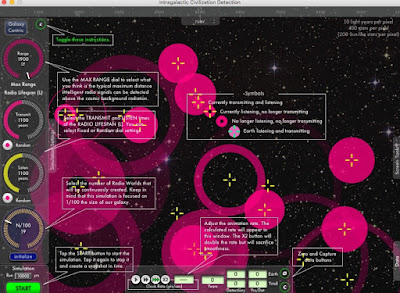I’ve often thought that the whole “where are they?” question about SETI (i.e., the Fermi Paradox) is bogus, both because the universe is just so BIG, and because we still understand so little about it, even though we have learned in recent years that planets and even “Earth-like” planets seem to be quite common throughout the Galaxy. As smart as some of us may be, it seems likely that we are still as clueless about major chunks of physics as scientists in the 1800’s were about quantum mechanics and the scale of the universe. If there are wormholes or quantum foam or gravitational technologies we won't develop for another 200 years, there could be aliens popping in and out all the time, and we wouldn't even know what to look for. It would be like an airliner passing 37,000 feet above some remote tribe of people who have never encountered other humans or modern technology, as unlikely as that may be today.
Such advanced beings might find radio wave communication to be as quaint as rubbing sticks together as an energy technology. I’ve also read articles suggesting that we ourselves are probably approaching the end of our “radio age” due to fiber optics and other technologies. Though we still send out a lot of radio waves, they tend to be more directional (like radar, microwaves, etc.) or short range (cell phone towers, Wifi, Bluetooth, etc.). Maybe technical civilizations only use radio waves for a few years and any continued or specialized use eventually becomes very efficient with very little leakage to space.
Somehow I wandered over to Centauri Dreams, a blog that periodically blows my mind with advanced space exploration ideas. I found an article “CitizenSETI” about a couple of guys (Roger Guay and Scott Guerin) who decided to work out this Fermi thing. A key part is the lifetime of an IC (intelligent civilization), which really means the DETECTABLE lifetime. If that is very short (e.g., humans have been broadcasting for about 110 years and listening for only about 60 years), and if such civilizations are widely separated in time and space, you will have a big “synchronicity” problem – finding times and places where someone is broadcasting AND someone in range is listening.
Roger Guay created a simulation with LiveCode, a modernized version of my old, beloved HyperCard for the Mac (screen shot above). In his Advanced Civilization Detection (ACD) program, he can set various assumptions about the spacing, lifetime, and other factors and run this simulation at high speed. Under most reasonable assumptions it creates a sort of “firefly” effect with detectable IC’s flashing in and out of existence and only rarely being seen by other IC’s. If these assumptions and simulations are reasonable, IC’s could be plentiful and it might still take hundreds of years of observation to catch one of these “fireflies” before it flickers out.
I've been interested in this subject since I read Intelligent Life inthe Universe by Carl Sagan and Iosif Shlovsky back in 1974. This was a pretty early work on exobiology (or perhaps astrobiology), a field that still lacks data but provides an interesting framework for thinking about everything we know about ourselves. My guess is that unicellular life has probably evolved in many places but that the leaps to multicellular, intelligent, and technological stages are much rarer, though certainly possible (current sample size is N=1 if you give humanity the benefit of the doubt as an IC).
Based on this simulation work, we are not likely to expand that sample size anytime soon. Here is Roger Guay’s final paragraph on Centauri Dreams:
Conclusions? The ACD simulation dramatically demonstrates that there is indeed a synchronicity problem that automatically arises when ICs attempt to detect one another. And for reasonable (based on Earth’s specifications) Drake equation parameter selections, detection potentials are shown to be typically hundreds of years apart. In other words, we can expect to search for a few hundred years before finding another IC in our section of the galaxy. When you consider Occam’s razor, is not this synchronicity problem the most logical resolution to the Fermi Paradox?
Of course this is hardly the last word on the subject of the Fermi Paradox. In fact, while reading the blog posts that triggered this one, I discovered a recently updated book that goes into much greater depth, If the Universe IsTeeming with Aliens … WHERE IS EVERYBODY?: Seventy-Five Solutions to the Fermi Paradox and the Problem of Extraterrestrial Life (2015) by Stephen Webb. I've read the Kindle sample and I may have to buy it despite my insane backlog of books already waiting to be read. Author Stephen Webb also has an interesting blog.


1 comment:
Thanks for sharing, nice post! Post really provice useful information!
Hương Lâm chuyên cung cấp máy photocopy, chúng tôi cung cấp máy photocopy ricoh, toshiba, canon, sharp, đặc biệt chúng tôi có cung cấp máy photocopy màu uy tín, giá rẻ nhất.
Post a Comment